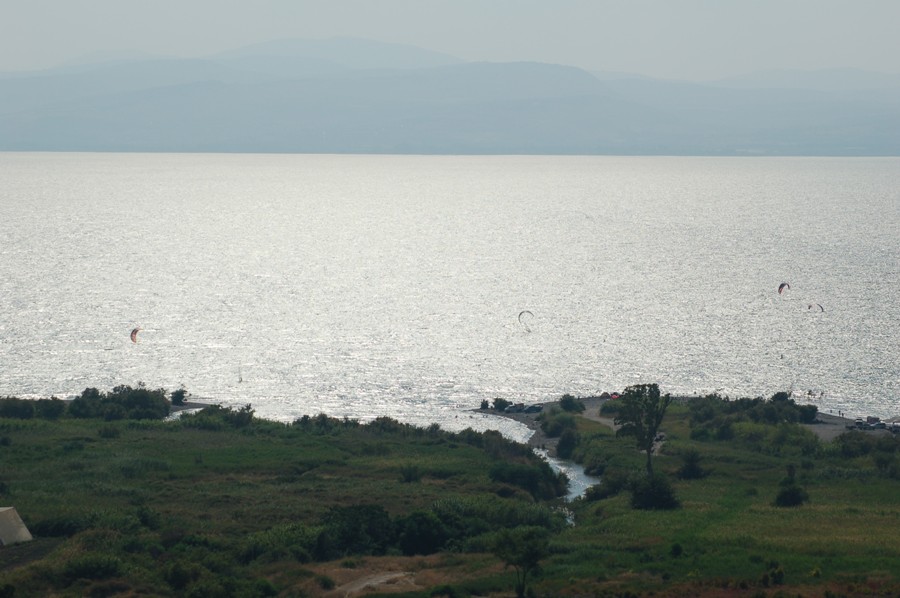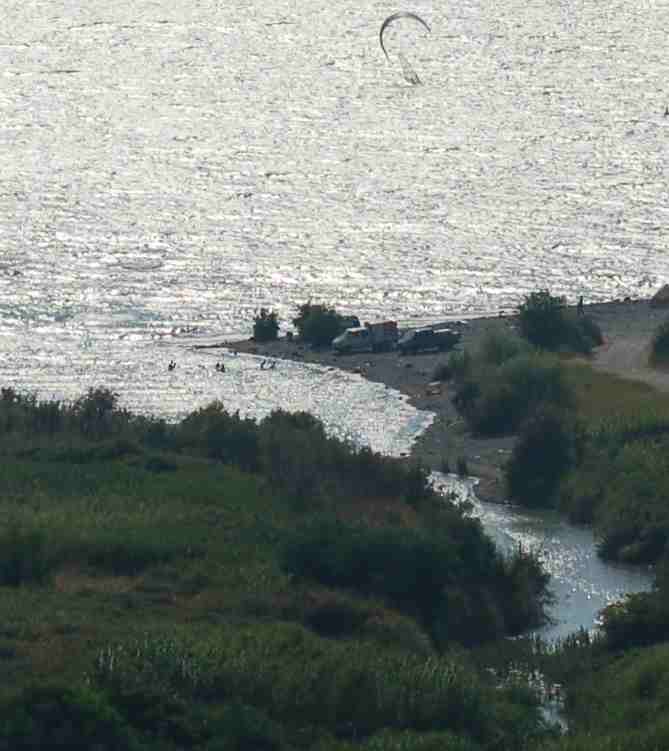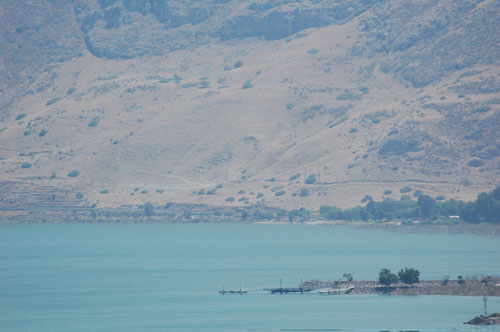
Photo of the Semakh Delta July 2006, Lake Tiberias
ISRAEL PHOTOS IV -- Pilgrimage |
The Demoniac Commandeered by a Legion
Mark 5
1 They came to the other side of the sea, into the country of the Gadarenes. 2 When he had come out of the boat, immediately a man with an unclean spirit
met him out of the tombs. 3 He lived in the tombs. Nobody could bind him any more, not even with chains, 4 because he had been often bound with fetters and
chains, and the chains had been torn apart by him, and the fetters broken in pieces. Nobody had the strength to tame him. 5 Always, night and day, in the
tombs and in the mountains, he was crying out, and cutting himself with stones. 6 When he saw Jesus from afar, he ran and bowed down to him, 7 and crying
out with a loud voice, he said, “What have I to do with you, Jesus, you Son of the Most High God? I adjure you by God, don’t torment me.” 8 For he said to
him, “Come out of the man, you unclean spirit!” 9 He asked him, “What is your name?” He said to him, “My name is Legion, for we are many.” 10 He begged him
much that he would not send them away out of the country. 11 Now on the mountainside there was a great herd of pigs feeding. 12 All the demons begged him,
saying, “Send us into the pigs, that we may enter into them.” 13 At once Jesus gave them permission. The unclean spirits came out and entered into the pigs.
The herd of about two thousand rushed down the steep bank into the sea, and they were drowned in the sea. 14 Those who fed them fled, and told it in the city
and in the country. The people came to see what it was that had happened. 15 They came to Jesus, and saw him who had been possessed by demons sitting, clothed,
and in his right mind, even him who had the legion; and they were afraid. 16 Those who saw it declared to them what happened to him who was possessed by
demons, and about the pigs. 17 They began to beg him to depart from their region. 18 As he was entering into the boat, he who had been possessed by demons
begged him that he might be with him. 19 He didn’t allow him, but said to him, “Go to your house, to your friends, and tell them what great things the Lord
has done for you, and how he had mercy on you.” 20 He went his way, and began to proclaim in Decapolis how Jesus had done great things for him, and
everyone marveled.
Most pilgrims looked for the site of this event on the eastern shore between En Gev and Kursi (the side of Wadi Semakh). At Kursi are the ruins of a Byzantine monastery at what is thought to have been Gergesa as the place recorded for this event in some early manuscripts.
The homeless man was living in tombs/burial caves and was exceedingly fierce and hostile. He scared people and had been in trouble with the law, fettered and chained, he had broken loose. There is no cliff overhanging the sea at Kursi. It is true the lake level was different in those days, but we do not know by how much. A hydroelectric project designed in the 1930's lowered the Jordan River bed where it flowed out of the lake by a few feet.
One pilgrim could not imagine a herd of pigs being able to drown themselves along the shore and looked at some of the nearby sheer cliffs and described the place as a "lover's leap" and the swine might have instead ran off the edge of the cliff. There is a low cliff overhanging the shore to the south of Kursi at Noqeib that is close to water level.
There is a place where the lake bed has a steep drop off close to shore as described by John MacGregor, The Rob Roy on the
Jordan (pgs 378-380), c. 1869, c. 1904:
"Between Wady Semakh (at the Kursi Junction,) and Wady Fik (near Kibbutz En Gev) there are at least four distinct localities where every feature in the Scripture account of this incident may be found in combination. Above there are rocks with caves in them, very suitable for tombs, and farther down there is ample space for tombs built on sloping ground--a form of sepulture far more prevalent in Scripture times than we are apt to suppose. A verdant sward is here, with many bulbous roots which swine might feed upon. And on this I observed--what is an unusual site--a very large herd of oxen, horses, camels, sheep, asses, and goats, all feeding together. It was evident that the pasturage was various and enough for all--a likely place for "a herd of swine feeding on the mountain."
"Khersa, near this, in ruins, was probably the Gergesa of old, and, as has been observed repeatedly by authors, this might well be in the "country of the Gadarenes," though a considerable distance from the town of Gadara. We are told that, "the whole herd of swine ran violently down a steep place." It does not say a "high" place, but "steep," and that they "ran" (not, they "fell") down this "into the sea." There are several steeps near the sea here, but only one so close to the water as to make it sure that, if a herd "ran violently" down, they would go "into the sea." But the place which I regard as most likely for the site of this event is at the end of the short plain under some rocks, and near the green plateau, where the swine could feed. Here, for a full half-mile, the beach is of a form different from any other round the lake, and from any I have noticed in any lake or sea before. It is flat until close to the edge. There a hedge of oleanders fringes the end of the plain, and immediately below these is a gravel beach, inclined so steep that, when my boat was at the shore I could not see over the top even by standing up, while the water alongside is so deep that it covered my paddle (seven feet long) when dipped in vertically a few feet from the shore. Now, if the swine rushed along this short plain towards this hedge of underwood (and in the delta of Semakh, their usual feeding place would be often amount to thick brushwood of that kind), they would instantly pass through the shrubs, and then down the steep gravel beyond into deep water, where they would surely be drowned."

Photo of the Semakh Delta July 2006, Lake Tiberias
Near Kursi Junction the stream flowing into the lake is seasonal. There were some steep banks a few feet high along the stream and a steep drop off along the shore. Seasonal floods from the Golan altered the shape of this stream delta and the depth of the water along the shore. A later journey to this area revealed the shoreline was once again altered by flood and/or bulldozer-earth moving equip. and this swimming hole was eliminated. There are pay for use beaches a short distance to the north of the parasailing location. The alteration of this beach may have been for economical reasons.
The shore may have changed over the course of 2,000 years for I found a description by S.C. Bartlett, president of Dartmouth College, and one time professor of theology at the University of Chicago. He wrote a travelogue, From Egypt to Palestine, in 1879: "...the ruins at Wadi Semakh, on the eastern shore, that are now called by the Arabs Kersa, or Ghersa, no doubt representing the ancient Gergesa. The name was first recovered, I believe, by our countryman Mr. Thompson. The stream, or creek, sixty feet wide at its mouth extends up half a mile or less to where the plain gives way to hills, and begins at the foot of the deep gorge. Some rubble masonry and a few cut stones lie beneath the water near the mouth of the river; and on the south bank, near the junction of the plain with the hills are, are the remains of an enclosing wall three feet thick; and within them, among other ruins, those of a rectangular building lying east and west; perhaps a khan. A thick jungle of canes, many of them thirty feet high, here line the banks. But the chief place of interest in the place centres in the region about a mile south, which having been examined by Thompson, Captain Wilson, Macgregor, and more casually by Tristam, is now conceded to be the place where the swine ran down into the sea."

Note: The language used to describe the event in the Gospels was from an era two thousand years ago, or later modification of the original text. The story is difficult to understand. I described the story as best I could with added description as to how it might have occurred. The important thread in the verses was that Jesus healed a mentally ill person who had been made an outcast due to his bad temper. The healing was as complete as the outcast was made sane and was able to return without being a threat to his community. As for demons going from a person to pigs and causing a stampede; that is doubtful. Stampedes amongst livestock were caused by loud noises or sometimes because of irrational fear spreading through the herd. Lemmings occasionally stampeded into the sea without reason or logic. Some people claimed to be several people as in a multiple personality disorder. This one claimed he was a legion.
During a one of my tours of Israel I bought a small inflatable boat in Tiberias and set out from a northwestern beach south of Magdala. To my left was Mt. Arbel. There are numerous burial caves along the SE face of Arbel and other caves on the mountain reportedly used by revolutionaries during the reign of Herod the Great as reported by the Roman era historian Josephus. As I rowed nearer to Magdala, the lakeshore road was above me to my left. From the lakeside road the land quickly descended to the lake. I rowed as fast as fast as I could toward Magdala, then one of my plastic-aluminum oars snapped with half of it descending to the bottom as my hand did not reach it in time. I had to use my remaining oar to paddle to shore as I was a long ways from shore and did not want to break my remaining oar. I saw the lake bottom was deep all the way to a narrow shelf near the shore. The area was strewn with talus boulders from the steep mountain and road construction. Stepping out of my boat and on to the shore I climbed a steep rise up to the asphalt road and walked back to the beach where I started. I do not think this is the place where the swineherds were. According to Josephus, Magdala was a large Jewish town. This mountain descending into the sea was in a Jewish neighborhood that would not have easily tolerated swineherds in their vicinity. On the other side of the lake were the Gentile towns of Hippos and Gadara of the Decapolis nearer to Kursi.

NW Corner of 'Sea of Galilee' July 2006

Some of my earlier descriptions of Kursi and the tale of the man possessed by a legion on the pages of Israel Photos III.
Nazareth Synagogue
Churches of the Annunciation
Latin Tradition -- Mount of Precipitation
Nazareth Aerial View
Museum of the Basilica
Hot Springs at Tiberias
Stone Water Jars at Capernaum
Capernaum
Tabgha
Bethsaida
A 1909 Galilee Fishing Description
The Giant Mustard Plant
Kursi and the Gadarene Demoniac
Jar of Ointment
Cana
Wheat and Tares